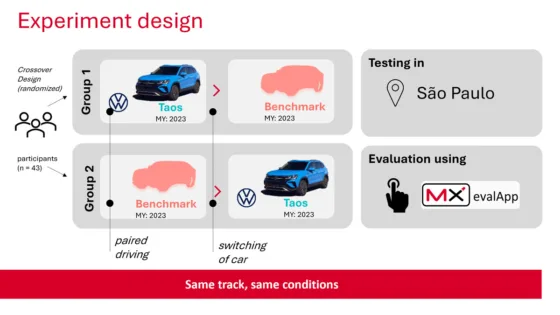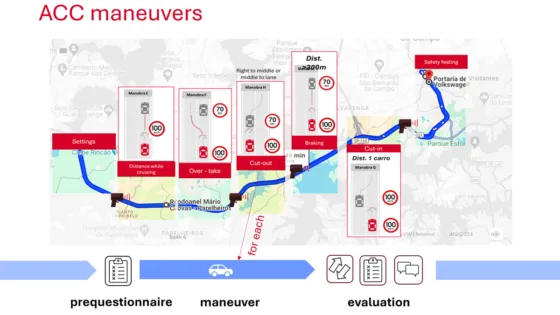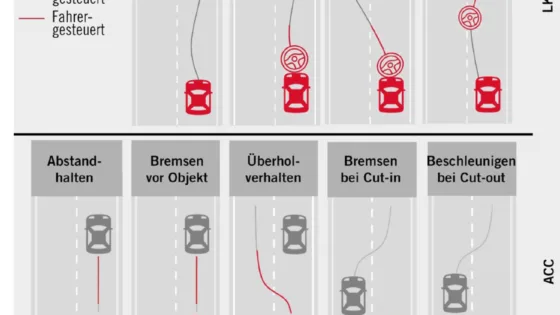Evaluating ADAS systems: UX, HMI, and technical performance
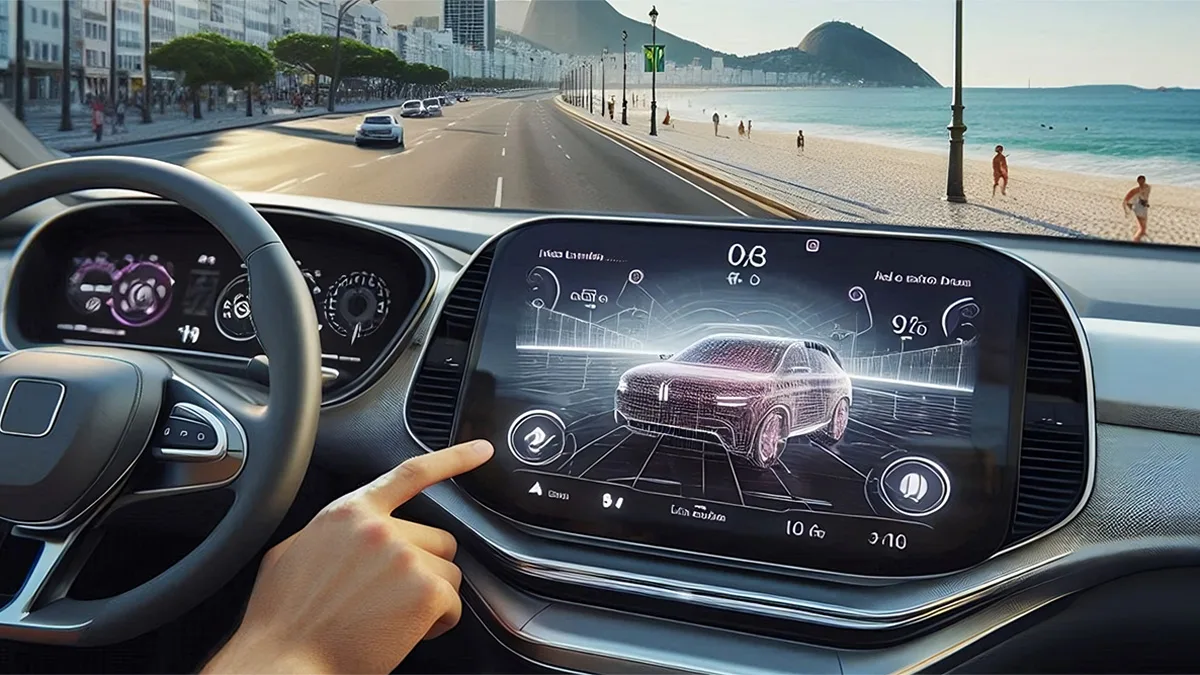
Advanced driver assistance systems (ADAS) have established themselves globally as a key innovation for increased safety and comfort. But how can an evaluation approach succeed that takes into account both technical performance and user experience – and does so in a market-specific way?
Joint research question with VW do Brasil: “How can an evaluation approach be developed that enables customer-oriented and tailored ADAS solutions for the South American region – while also being transferable to other markets with different cultural contexts?”
Market-Specific Challenges in South America
The South American market accounts for around 5% of the global automotive market, and Advanced Driver Assistance Systems (ADAS) are also gaining increasing importance here. While many consumers are convinced by the arguments of safety and comfort, in practical use the systems often fall short of expectations. Recent research findings confirm persistently low customer satisfaction and user acceptance.
One key reason for this is the lack of focus on user experience and the holistic integration of driver assistance functions with the human-machine interface (HMI) during development. Whether and how intuitive or even pleasant the systems are for the driver, and how effectively human and vehicle interact, has so far been barely considered.
In addition, market-specific characteristics in South America are often ignored: cultural differences that influence driving styles, or the challenging infrastructure. Poor road conditions, dense urban traffic, high speeds on intercity roads, and extreme altitudes require tailored solutions. Many OEMs take the easy route and transfer platform solutions that work well in Europe or Asia directly to South America without adaptation. In practice, this approach fails – customer expectations remain unmet, and the systems are ultimately rejected.
An Integrative Evaluation Approach for Local Requirements
To address the challenges described above, we developed a holistic evaluation approach that not only covers technological aspects but also incorporates the local cultural, infrastructural, and user-specific conditions. This approach enables a region-specific and intelligent assessment of driver assistance systems – with the goal of creating tailored yet transferable solutions.
The evaluation process we developed:
- combines functional performance data, user-friendliness, and HMI communication with cultural influencing factors,
- is based on clearly defined KPIs,
- and enables the correlation of objective metrics with subjective user experiences.
In close collaboration with the VW do Brasil team, we adapted the process to regional requirements. With the help of the MXevalApp, the local team was able to quickly and systematically familiarize itself with the study concept – providing an efficient starting point for valid and practice-oriented insights.
Study Design for Integrative ADAS Evaluation
For a comprehensive analysis, we conducted a participant study with 43 participants, including five subject matter experts. The focus was on the ADAS functions Lane Keeping Assist (LKA) and Adaptive Cruise Control (ACC) in a 2024 VW Taos, which were tested in direct comparison with a competitor vehicle.
The tests were conducted under real-world driving conditions, capturing both objective system performance data and subjective user feedback. To systematically collect and evaluate both qualitative and quantitative data, we used the evaluation app, MXevalApp. This combination of methods allowed for an integrative assessment of the user experience and the functional performance of the driver assistance systems.
Findings and Implications
The evaluation of driver assistance systems is complex: In addition to objective performance data, subjective impressions from the drivers also play a key role. However, until now, there have been no standardized methods that integratively capture both perspectives.
Our methodology shows great potential for cross-market standardization of ADAS evaluation. It serves as the foundation for the targeted further development of driver assistance systems – aligned with real customer expectations. Suppliers in the first and second tiers, as well as service providers in the areas of user experience, usability, and human-centered development, particularly benefit from these insights.
The integrative evaluation approach not only delivers valid results and concrete recommendations for action – it also provides a scalable assessment framework that can be adapted to regional specifics while paving the way for cross-market standardization. This creates a solid foundation for the targeted further development of ADAS – customer-focused and globally applicable.
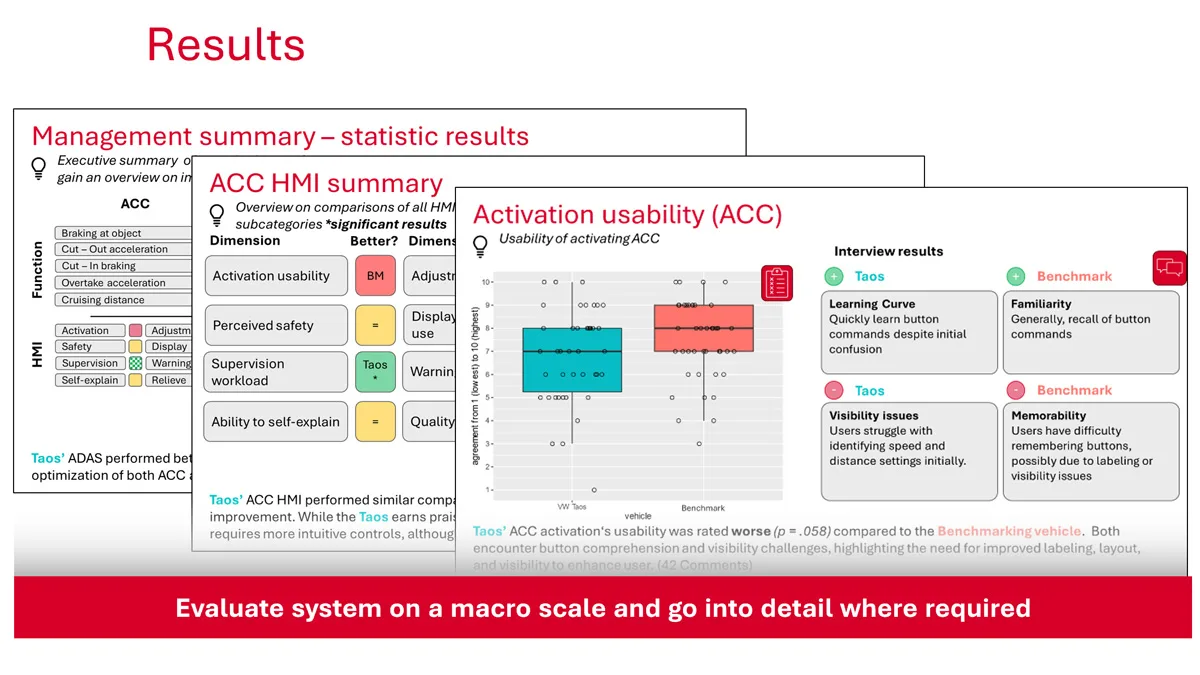
Further Information
- Full Paper
For those who wish to dive deeper into the topic and read the detailed analysis, the paper offers valuable insights.
„Holistic Evaluation Methodology of the User Experience of Driver Assistance Systems in the Combination of Human-Machine-Interface and Functional Performance”
Seda Aydogdu, Dr. Thomas Kersten, Kevin Schuler, Prof. Bernhard Schick and Gioele Micheli
- Publication in ATZ – Automobiltechnische Zeitschrift
We are pleased that ATZ also emphasizes the significance of our work for the automotive industry and has dedicated a full article to it in the April 2025 issue:
„Bewertung von Funktionen für ADAS und HMI aus Kundensicht am Beispiel Brasilien“


